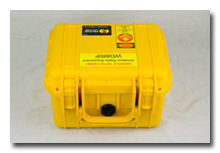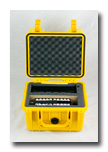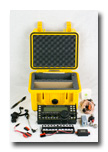by William Eric McFadden
Note: While I still have my Elecraft KX3, I no longer carry it in the KX3 Travel Kit, choosing, instead, to carry the Enhanced KX3 Travel Kit or the KX3 Mini Travel Kit. This page about the KX3 Travel Kit will remain active for archival purposes.
The KX3 Travel Kit is a small but complete low-power HF+6m station in a waterproof and extremely rugged Pelican #1300 case. The KX3 Travel Kit is designed for rapid deployment following transport by bicycle, foot, canoe, or kayak. In its typical configuration, the KX3 Travel Kit weighs about 6½ pounds.
The KX3 Travel Kit is under continuous development. Photos may not represent the current state of the station. This page will change as various ideas are tested and accepted or rejected.
-
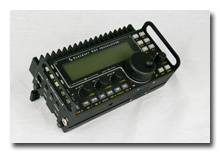 The heart of the KX3 Travel Kit is an Elecraft KX3
low-power transceiver equipped with the KXAT3 Internal Automatic Antenna Tuner
module, the KXFL3 Dual-Passband Roofing Filter module, AK6Q Side KX Endplates,
and VE7FMN Cooler KX Lite heatsink.
The heart of the KX3 Travel Kit is an Elecraft KX3
low-power transceiver equipped with the KXAT3 Internal Automatic Antenna Tuner
module, the KXFL3 Dual-Passband Roofing Filter module, AK6Q Side KX Endplates,
and VE7FMN Cooler KX Lite heatsink.
The trail-friendly KX3's all-band (160-6m) coverage, all-mode (CW/SSB/AM/FM/data) capability, competition-grade receiver, truly generous feature-mix, small size, low weight, and battery-friendly design make the KX3 an extraordinary field-radio.
-
The KX3 can operate over a voltage range of 8vdc to 15vdc. Internally, the KX3 can accomodate eight AA cells. A coaxial power socket is provided for connection to an external power source. When internal batteries are installed and external power is connected, the rig will use the source having the higher voltage.
Internal Batteries-
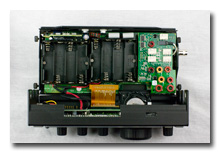 The KX3 internal battery holders accomodate eight AA cells. When
filled with 1.2v NiMH cells, this produces a nominal 9.6-volt battery-pack.
Because of reports from W8MHV of poor battery life when powering his
KX3 with internal NiMH cells1, at this
point in time I have decided against keeping NiMH cells in the KX3 or
purchasing the KXBC3 Internal NiMH Charger / Real-Time Clock module.
The KX3 internal battery holders accomodate eight AA cells. When
filled with 1.2v NiMH cells, this produces a nominal 9.6-volt battery-pack.
Because of reports from W8MHV of poor battery life when powering his
KX3 with internal NiMH cells1, at this
point in time I have decided against keeping NiMH cells in the KX3 or
purchasing the KXBC3 Internal NiMH Charger / Real-Time Clock module.
It's possible I might decide to keep a set of lithium primary cells (1.5v, 2.8 - 2.9Ah) installed in the KX3 in case of an emergency. If so, I might choose to install just seven cells and use a dummy cell in the eighth position to ensure that an external power source (see below) always measures higher in voltage than the internal battery.
-
For most operations with my KX3, I will rely on an external battery.
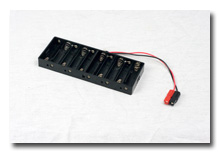 For short-duration field operations, I have a rugged ten AA-cell holder
(Batteries America p/n 10AAT, photo | link)
I can fill with ten 1.2v NiMH cells or, in a pinch, eight alkaline cells
(1.5v, 2.2 - 2.7Ah) or lithium primary cells (1.5v, 2.8 - 2.9Ah) plus
two dummy cells. Either way it's configured, this pack is a nominal 12-volt
pack. I am currently using a set of ten Sanyo/Panasonic Eneloop 1900mAh NiMH cells
with this battery-holder. (See KX1 Mini Travel Kit
for a discussion on spring-type AA-cell holders.)
For short-duration field operations, I have a rugged ten AA-cell holder
(Batteries America p/n 10AAT, photo | link)
I can fill with ten 1.2v NiMH cells or, in a pinch, eight alkaline cells
(1.5v, 2.2 - 2.7Ah) or lithium primary cells (1.5v, 2.8 - 2.9Ah) plus
two dummy cells. Either way it's configured, this pack is a nominal 12-volt
pack. I am currently using a set of ten Sanyo/Panasonic Eneloop 1900mAh NiMH cells
with this battery-holder. (See KX1 Mini Travel Kit
for a discussion on spring-type AA-cell holders.)
1 The KX3's power-output control doesn't directly set the transmitter output power. Rather, it tells the radio what power-output the operator wants and the radio makes sure that output-power is generated. Since P=IxE, lower supply voltage (E) means more current (I) must be drawn to produce a desired power (P).
-
-
The KX3 covers all bands 160m through 6m. It would be very challenging (or, more likely, impossible) to find a single easy-to-deploy field antenna that works well on all of these bands. Fortunately, I am primarily interested in operating on the bands 80m through 10m while in the field, making the task of finding a single field-deployable antenna that's small enough to pack easily much more manageable.
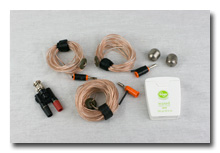 Currently, for 10m-40m, I carry a 28' end-fed wire and three shorter counterpoise wires.
For 80m, I have a 58' (source)
end-fed wire I have tested once in the in the field. The low-hanging 58'
wire tuned well on 80m only when the 28' wire and both shorter wires were
connected as a counterpoise.
Currently, for 10m-40m, I carry a 28' end-fed wire and three shorter counterpoise wires.
For 80m, I have a 58' (source)
end-fed wire I have tested once in the in the field. The low-hanging 58'
wire tuned well on 80m only when the 28' wire and both shorter wires were
connected as a counterpoise.
I use a BNC-to-dual-banana-socket adapter to connect the end-fed wire and counterpoise wires to the KX3.
To hang wire antennas in trees, I carry a 100-yard spool of dental floss and a couple of large fishing weights.
Descriptions of field-deployable antennas I've used with the larger K2 Travel Kit are located here. Any of the antennas that worked well with the K2 Travel Kit should work well with the smaller KX3 Travel Kit but would need to be carried externally.
-
Electronic Keyer & Paddle
-
The KX3 has a perfectly adequate built-in memory keyer so I don't need to carry an external memory keyer with the KX3 Travel Kit.
Having given up on dual-lever keyer paddles, I chose not to purchase the otherwise excellent Elecraft KXPD3 Precision Iambic Keyer Paddle for use with my KX3.
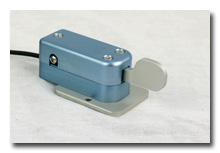 I currently use an American Morse Equipment (link)
Mini-B Miniature Single Lever Paddle (photos: 1 | 2)
when keying electronically in the field. This beautifully-machined little
paddle replaced a lightweight Whiterook MK-33 Mini Single Lever Paddle
(photo | link).
I currently use an American Morse Equipment (link)
Mini-B Miniature Single Lever Paddle (photos: 1 | 2)
when keying electronically in the field. This beautifully-machined little
paddle replaced a lightweight Whiterook MK-33 Mini Single Lever Paddle
(photo | link).
I have developed a bracket to mount the Mini-B on the KX3 transceiver (photos: 1 | 2 | 3 | 4). Initial tests indicate this bracket works well.
I have purchased the AME The Porta-Paddle Leg Mount (link) for use with the Mini-B but have not tried it in the field. The Leg Mount will not fit in the Pelican #1300 Case.
I would dearly love to have the gorgeous Begali Adventure Mono paddle (link) to use with my KX3 but at a price of €258 for the key plus €28 for the KX3 mounting bracket, I am unlikely to be able to purchase one anytime soon.
-
-
My primary microphone for voice modes (SSB/AM/FM) with the KX3 is an Elecraft MH3 Hand Microphone. I have received reports of excellent audio quality when I've used this microphone during SSB and AM QSOs. Unfortunately, this microphone consumes a lot of volume in the Pelican #1300 case and I don't tend to carry this microphone as part of the KX3 Travel Kit.
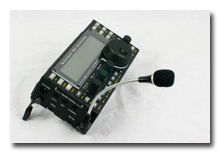 For field use, I carry a very small and very inexpensive gooseneck mini-microphone
(photos: 1 | 2).
This mic was identified as HDE Mini 3.5mm Flexible Microphone for PC Laptop Skype
and cost only 50¢ plus shipping at Amazon.com (link).
I have received reports of good audio while running AM so the mic should work
well enough for occasional SSB operation in the field while consuming very
little volume in the Pelican #1300 case. This microphone lacks a PTT button;
I'll need to use VOX or the KX3's front-panel XMIT button. This mic requires
a mic-gain of approximately 45.
For field use, I carry a very small and very inexpensive gooseneck mini-microphone
(photos: 1 | 2).
This mic was identified as HDE Mini 3.5mm Flexible Microphone for PC Laptop Skype
and cost only 50¢ plus shipping at Amazon.com (link).
I have received reports of good audio while running AM so the mic should work
well enough for occasional SSB operation in the field while consuming very
little volume in the Pelican #1300 case. This microphone lacks a PTT button;
I'll need to use VOX or the KX3's front-panel XMIT button. This mic requires
a mic-gain of approximately 45.
-
Using Acrobat Reader X and an available duplex color printer, I printed the KX3 Owner's Manual in half-size "booklet" form. This booklet, log sheets, and paper for CW copy are carried above the egg-crate foam in the lid of the Pelican #1300 case.
The KX3 has a small built-in speaker but I prefer to copy CW through stereo headphones, particularly since the KX3 provides very useful simulated stereo audio effects for CW reception. I carry a pair of iHip-brand ($5 at Big Lots) shoestring-lead earbuds in the KX3 Travel Kit. It's my hope that these earbuds might be a bit more rugged than the usual inexpensive earbuds.
-
A key question to be answered in the design of the KX3 Travel Kit was the choice of case for safely transporting the equipment while in the field. I am a big fan of the Pelican (link) line of cases because they are extremely rugged and are fully waterproof. I considered three Pelican cases to protect my KX3 and accessories: the #1200 (because I already had one available), the #1300, and the #1400.
The Pelican #1200 case (0.16 ft3, 2.65 lbs, link) I had used with my KX1 Mini Travel Kit would be easy to transport but is small enough that only the transceiver, key, microphone, earbuds, and interconnects would fit within it leaving the antenna, external battery, and other items to be carried externally.
The Pelican #1300 case (~ $45, 0.23 ft3, 3.09 lbs, 12.35 lbs buoyancy, link) has essentially the same lid dimensions as the #1200 but is 2" deeper. The KX3 nicely fits vertically in the #1300 case, leaving significant volume available for key, mic, interconnects, antenna, string, etc. The #1300 lid dimensions are close enough to those of the #1200 that the #1300 fits well on the bicycle using the same fixture I had devised for the KX1 Mini Travel Kit.
The Pelican #1400 case (~ $70, 0.31 ft3, 3.97 lbs, 20.06 lbs buoyancy, link) is larger than the #1200 in all three dimensions; the KX3 and everything else should fit nicely within it but the resulting package might be heavier than I want for human-powered transport.
After much consideration, I decided to commit to the Pelican #1300 and ordered a highly-visible yellow example with pick-n-pluck foam.
-
I built the KX3 Travel Kit to encourage me to engage in impromptu human-powered-transport field operations. I will be carrying the station while biking, hiking, and canoeing/kayaking.
Biking-
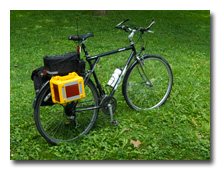 Although the Pelican #1300 case fits on the same easy-to-mount, easy-to-remove,
rear-rack-fixture I had devised to safely transport the KX1 Mini Travel Kit
on my bicycle (photo), after a few expeditions I realized my
original fixture wasn't strong enough for the heavier KX3 Travel Kit and I had a new
fixture fabricated out of ¼" steel rod by a local machinist who is also an avid bicyclist.
Although the Pelican #1300 case fits on the same easy-to-mount, easy-to-remove,
rear-rack-fixture I had devised to safely transport the KX1 Mini Travel Kit
on my bicycle (photo), after a few expeditions I realized my
original fixture wasn't strong enough for the heavier KX3 Travel Kit and I had a new
fixture fabricated out of ¼" steel rod by a local machinist who is also an avid bicyclist.
I chose the bright yellow color of the Pelican case in part to increase the visibility of my bicycle and myself to motorists and I have added silver and yellow reflective material to the case to further increase visibility during low-light conditions.
I first carried the KX3 Travel Kit on my bicycle for the 2014 Flight of the Bumblebees. The KX3 Travel Kit traveled quite well on the bicycle over the hilly 15-mile round-trip. Since then, I've also carried the KX3 Travel Kit on my bicycle for the 2014 NE QRP Afield, the 2015 Flight of the Bumblebees, the 2016 Flight of the Bumblebees, the 2017 Flight of the Bumblebees, and the 2018 Flight of the Bumblebees events.
-
I've made one short hike with the KX3 Travel Kit, carrying it up to Lookout Point in Athens, Ohio for the 2014 Scorch Your Butt Off event. Carrying the Pelican #1300 case by its handle worked well enough on this short hike but it was clear some sort of backpack would have worked better.
Since I'm hoping to hike more with the KX3 Travel Kit, and possibly even to activate SOTA (link) summits in Ohio, I've purchased an inexpensive-yet-versatile LowePro Traveler 150 (link) photography backpack and I've built the Enhanced KX3 Travel Kit.
-
Given the waterproof Pelican #1300 case's 12.35 lbs of bouyancy, I am confident that the complete KX3 Travel Kit will float high in the water in the event of a canoe or kayak misadventure. I chose the bright yellow color of the case in part to aid in recovery of the station in just such an event.
More details on transport of the KX3 Travel Kit will appear here as I begin to work out the transportation and deployment logistics.
-
